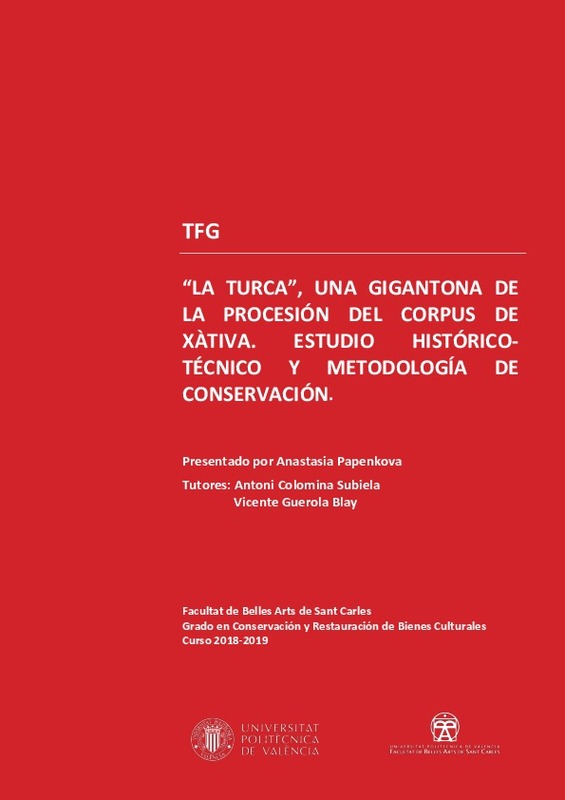|
Resumen:
|
[EN] The festive culture is full of popular representations which enrich the collective imagination, as powerful elements that reinforce the sense of belonging and identify the social groups. The giants and big-heads are ...[+]
[EN] The festive culture is full of popular representations which enrich the collective imagination, as powerful elements that reinforce the sense of belonging and identify the social groups. The giants and big-heads are the proof of this folkloric wealth, very symbolically linked to the tradition of immaterial connotation.
In this final work of degree, is presented the iconographic and historical contextualisation of one of the carton-stone giants that paraded for years on the occasion of the feast of Corpus Christi in Xativa, in the province of Valencia. It also has a technical, material and physiognomic examination of the sculpture, popularly known as «La Turca». To sum up the conclusion is that it belongs to the late nineteenth and early twentieth centuries.
As a festive element of processional uses it s presents important problems of structural and dimensional type, as well as the previous ones, especially located in the polychromy areas, with the purpose of recover its appearance with the superposition of varnishes and repaints.
After determining the status of conservation and according to all the preliminary studies, starts the intervention in the order to guarantee the structural stability of the carton support and the strata of the polychromy, to recover it s original size, remove the historical chromatic additions and meet the needs of Conservation of the textile complements and other trappings that accompany the work.
[-]
[ES] La cultura festiva está repleta de representaciones populares que enriquecen el imaginario colectivo, como poderosos elementos que refuerzan los mecanismos de pertenencia e identidad de los grupos sociales. Los gigantes ...[+]
[ES] La cultura festiva está repleta de representaciones populares que enriquecen el imaginario colectivo, como poderosos elementos que refuerzan los mecanismos de pertenencia e identidad de los grupos sociales. Los gigantes y cabezudos son una prueba de esta riqueza folklórica, muy ligada simbólicamente a la tradición de connotación inmaterial.
En el presente trabajo final de grado se realiza la contextualización iconográfica e histórica de uno de los gigantes de cartón-piedra que desfilaron durante años con motivo de la festividad del Corpus Christi en la localidad valenciana de Xàtiva. Asimismo, se lleva a cabo el examen técnico, material y fisonómico de la escultura, conocida popularmente como La turca , tras el cual ha podido concluirse que su datación se estima entre finales del siglo XIX y principios del XX.
Como elemento festivo de uso procesional presentaba importantes problemas de tipo estructural y dimensional, así como intervenciones anteriores que, especialmente localizadas en las áreas de la policromía, intentaron actualizar reiteradamente su aspecto con la superposición de barnices y repintes.
Después de determinar su estado de conservación y de acuerdo con todos los estudios preliminares se realiza su intervención para garantizar la estabilidad estructural del soporte de cartón y los estratos de policromía, recuperar su tamaño original, eliminar las adiciones cromáticas históricas y atender a las necesidades de conservación de los complementos textiles y otros atavíos que acompañan a la obra.
[-]
The festive culture is full of popular representations which enrich the collective imagination, as powerful elements that reinforce the sense of belonging and identify the social groups. The giants and big-heads are the ...[+]
The festive culture is full of popular representations which enrich the collective imagination, as powerful elements that reinforce the sense of belonging and identify the social groups. The giants and big-heads are the proof of this folkloric wealth, very symbolically linked to the tradition of immaterial connotation.
In this final work of degree, is presented the iconographic and historical contextualisation of one of the carton-stone giants that paraded for years on the occasion of the feast of Corpus Christi in Xativa, in the province of Valencia. It also has a technical, material and physiognomic examination of the sculpture, popularly known as «La Turca». To sum up the conclusion is that it belongs to the late nineteenth and early twentieth centuries.
As a festive element of processional uses it s presents important problems of structural and dimensional type, as well as the previous ones, especially located in the polychromy areas, with the purpose of recover its appearance with the superposition of varnishes and repaints.
After determining the status of conservation and according to all the preliminary studies, starts the intervention in the order to guarantee the structural stability of the carton support and the strata of the polychromy, to recover it s original size, remove the historical chromatic additions and meet the needs of Conservation of the textile complements and other trappings that accompany the work.
[-]
|







